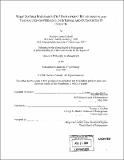| dc.contributor.advisor | Thomas A. Kochan. | en_US |
| dc.contributor.author | Bidwell, Matthew James, 1974- | en_US |
| dc.contributor.other | Sloan School of Management. | en_US |
| dc.date.accessioned | 2005-09-27T17:16:11Z | |
| dc.date.available | 2005-09-27T17:16:11Z | |
| dc.date.copyright | 2004 | en_US |
| dc.date.issued | 2004 | en_US |
| dc.identifier.uri | http://hdl.handle.net/1721.1/28604 | |
| dc.description | Thesis (Ph. D.)--Massachusetts Institute of Technology, Sloan School of Management, 2004. | en_US |
| dc.description | Includes bibliographical references (p. 218-228). | en_US |
| dc.description.abstract | Firm boundaries have been the subject of much scholarly interest in recent years, as firms increasingly hire external, "contingent" workers and outsource previously core activities. However, little empirical research has directly studied what happens differently inside the firm's boundaries, versus across them. In my dissertation I study what firm boundaries do at two different levels of analysis: the individual employment relationship; and the overall transaction. Specifically, I carry out a detailed comparison of the use of regular employees, independent consultants and outsourced vendors on Information Technology (IT) projects within a large financial services institution. This comparison draws on a project survey, extensive interviews and observation, and analysis of contracts and accounting data. The first piece of empirical work examines how independent consultants, who are outside the firm's internal labor market, are treated differently from regular employees. My findings challenge theories that argue that Human Resource (HR) practices play an important role in how workers are managed. Instead, managers view and treat consultants and employees very similarly. Furthermore, consultants were laid off at a similar rate to employees during a recession. Based on these findings, I argue that scholars should pay less attention to HR practices in understanding workers' relationship with their employers. Instead, I highlight how the knowledge that workers acquire through their work and the way that employment decisions are taken within the firm play a central role in shaping workers' employment relationships. A second section compares the governance of internal projects with projects performed by an outsourced vendor. I find that the structure | en_US |
| dc.description.abstract | (cont.) of the organization imposes greater limitations on how managers can contract with one another within the firm compared to between firms. I also find that, contrary to much of the theorizing about firm boundaries, managers were able to exercise extensive authority over external projects. The final section of the dissertation draws on this fieldwork to compare three theoretical perspectives on firm boundaries, based on employment relationships, transaction governance and asset ownership. I argue that formally integrating employment into the theory of the firm would improve our understanding of what firm boundaries do. | en_US |
| dc.description.statementofresponsibility | by Matthew James Bidwell. | en_US |
| dc.format.extent | 271 p. | en_US |
| dc.format.extent | 14546321 bytes | |
| dc.format.extent | 14582051 bytes | |
| dc.format.mimetype | application/pdf | |
| dc.format.mimetype | application/pdf | |
| dc.language.iso | en_US | |
| dc.publisher | Massachusetts Institute of Technology | en_US |
| dc.rights | M.I.T. theses are protected by copyright. They may be viewed from this source for any purpose, but reproduction or distribution in any format is prohibited without written permission. See provided URL for inquiries about permission. | en_US |
| dc.rights.uri | http://dspace.mit.edu/handle/1721.1/7582 | |
| dc.subject | Sloan School of Management. | en_US |
| dc.title | What do firm boundaries do? : employment relationships and transaction governance in internal and outsourced IT projects | en_US |
| dc.type | Thesis | en_US |
| dc.description.degree | Ph.D. | en_US |
| dc.contributor.department | Sloan School of Management | |
| dc.identifier.oclc | 57518629 | en_US |
